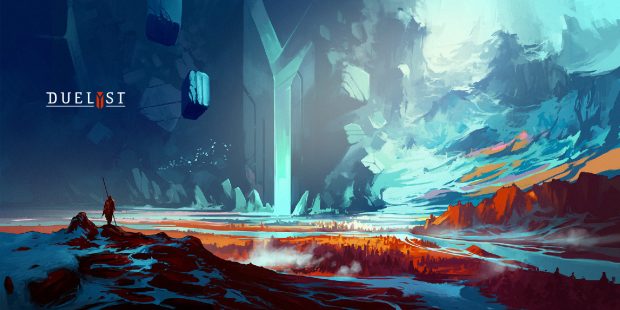
It’s astonishing how a 5×9 tiled board can utterly metamorphose the collectable card game (CCG) genre. As your first ever match commences with an opponent squaring off against you on the other corner of the battlefield, you look around. The bottom of the screen exhibits the fundamental tropes inherent in games involving the shuffling of thin, painted cardboard, such as Yu-Gi-Oh! or Magic: The Gathering.
There’s your hand (called the action bar here) boasting a mix of cards with varying costs, interactions and boards impact, but all of them are animated in nostalgic – but vibrant – pixelated form. There’s your deck of cards that you draw from once at the end of your turn. The deck itself is something you’d likely have pieced together yourself from the collection of cards you’ve amassed over the course of your playtime. But it’s the existence of the deck itself that you know luck is a deeply embedded component here, as you have no certainty over what you’ll draw.
The deck building element, collecting cards, the luck of the draw, operating with the resources available… if you’re familiar with playing cards that aren’t poker, these elements are intuitive. But none of that would prepare you for the culture shock you’d experience if you wade into Duelyst blind. Looking at the 5×9 battlefield, you might think you’re experiencing an innovative approach to chess. You wouldn’t be too far off the mark.
Snakes and Ladders… minus the Snakes
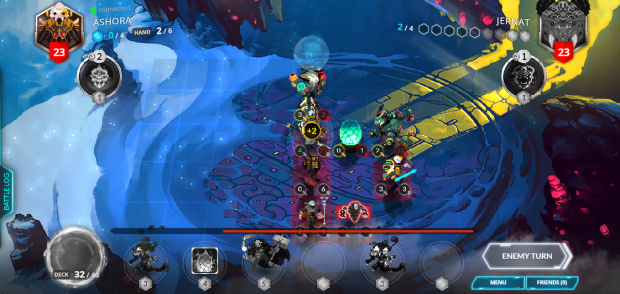
Counterplay Games‘ novel spin with the digital CCG genre has created a pastime that’s a paradox of tastefully conventional and refreshingly new. The developers have taken the rigidity and tactical depth of chess and married it to the game of probability, customisation and card strategy. With all these components together, Duelyst stands as a highly underrated gem that can facilitate short, casual sessions of gaming fun or highly protracted competitive gameplay.
However, casual player or not, you’d be spending most of your time in ranked matches, where you may gradually ascend through the bronze, silver, gold and diamond tiers, before hopefully reaching the zenith at S-rank. Competition is stiff, especially in the higher tiers, and you’ll soak up ever more interesting tactics and card synergies as you climb the ranked ladder. At the start of a new month, your rank gets dialled down a bit depending on your performance the previous month, so you don’t stay locked in a rank once you reach it.
This is because reaching the upper ranks grant rewards that are cumulative. Gold rank players will gain, among other things, a free legendary card at the end of the month, while diamond rank players gain more freebies on top of the gold rank rewards.
You could ignore your position on the ladder entirely, but competitive players will find this primary game mode highly stimulating and rewarding.
The Breakdown
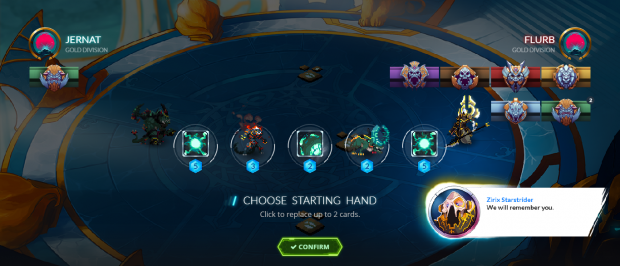
The essence of the game is simple to grasp. Your avatar is the spiritual counterpart to a chess game’s King piece, called a general. The difference is that a general is far more useful, far more durable and far cooler looking. Generals can deal 2 damage in melee and has 25 hit points, with the objective being to reduce the opposing general’s life total to zero.
There are a total of 12 generals (6 initially) to choose from, each having a unique ability called a Bloodborn Spell that define the deck its apart of. This ability can be used once every two turns until about turn 8; after that, you can cast it once every turn. For instance, general Argeon Highmayne’s spell is called Roar that imbues a friendly nearby unit with a +2 attack stat.
Further assisting your dominion over the opposition are a bevy of cards ranging from minions to place and move on the tiled board, artefacts that can be equipped by your general, to spells with different effects. Each card has a mana cost which is the resource needed to play them. Player one (on the left side of the field) starts with two mana while player two starts with three, with your mana increasing by one each turn up to a ceiling of 9 mana.
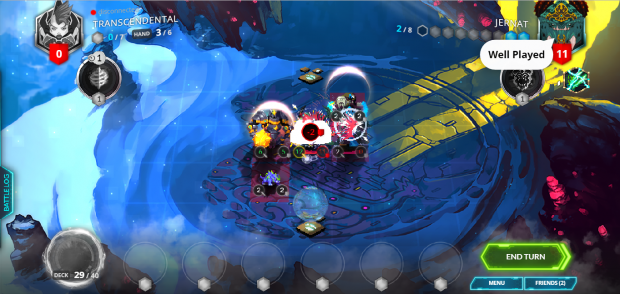
In other words, as the game prolongs both players will have the opportunity to play more resource intensive cards or more cards in a single turn. Resource management is crucial though, as it is sometimes better to cast a single, relevant cheap card with spare mana being wasted instead of playing multiple expensive cards at an inopportune moment.
As mentioned earlier, you draw one card at the end of your turn, but you could also replace a card at any time just once during your turn, which increases the probability of having the exact card you need at the right time.
Location, location, location!
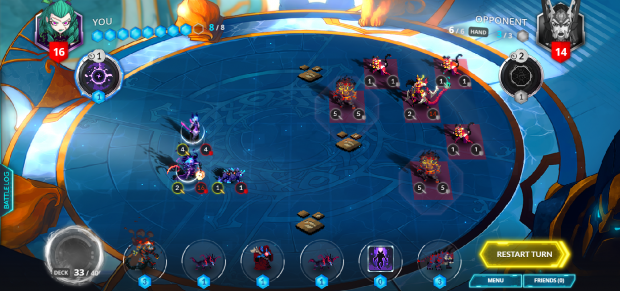
Positioning has a significance here that no other card game has replicated. As you can only move your general and units up to 2 spaces each a turn, how offensively or defensively you place them relative to your opponent is the difference between triumph and you becoming a pixelated blood stain on a square tile.
If you just summoned a Four Winds Magi minion that reads “whenever you cast a spell, deal 1 damage to the enemy general,” for example, you’d generally want to place it as far away from any opposing units as possible so that you could reap its effect for longer. However if your general is low on health and has to retreat, you could instead place that same minion right in front of you to block the opponent from pulverising your vulnerable linchpin.
Well placed minions either amplify your offensive potential or make it nigh impossible to penetrate a defensive position. Mastering this deceptively simple part of the game takes time, but monumentally rewarding in itself.
Faction Action
Duelyst encourages tons of different play styles and deck building shenanigans, though it is marginally limited to 6 distinct and well-stylised factions. This segregation dictates to a large degree how your deck functions and the card pool available to a deck. Each faction has two generals available and a selection of cards usable only by that faction. On the other hand, there’s a large arsenal of neutral cards that are usable by any faction and can be slotted into your deck depending on what it’s trying to accomplish.
Factions also have a level cap of 50 that you can aspire to reach as you play games using them. You earn the faction’s basic cards in the early levels, and at level 11 you unlock that faction’s second general. Other unlocks later down the line have primarily aesthetic value and not much else, so it won’t affect actual game play.
Here’s a rough overview of three of the six factions:
- Lovers of synergy, backstabs and spell barrages will find themselves gravitating toward the assassin-themed Songhai. However, their minions are typically weak and require combinations of other cards to fully realise their power.
- The desert dwelling, technologically superior Vetruvian dominate through potent card draw effects, forcing the opponent into difficult positions, or controlling the battlefield with creatures that constantly generate value or require immediate answers. They can have a potent board presence and very powerful in drawn out matches, but are very weak to ranged threats and a lot of their creatures die easily despite having strong effects.
- Magmar Aspects play massive or ferocious creatures that hit exceedingly hard or fast (or both) and have access to very potent removal spells to control the field in your favour. On the flip side, their card costs can be rather steep for what they do, and a lot of their cards act like a double edge sword that inflict pain onto themselves too.
You’re not limited to only playing a single faction or general, but you’d generally want to stick to one in the beginning as it’s difficult to hoard enough resources to attain the cards you need for multiple decks.
With You In Spirit (Orbs)
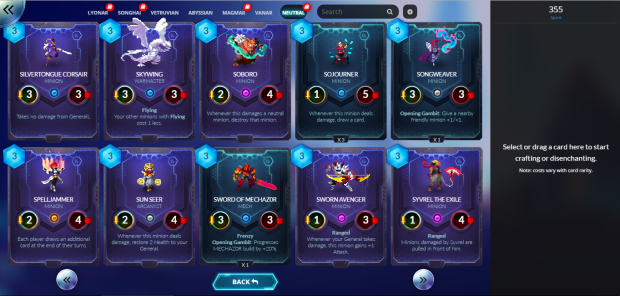
Fortunately, earning cards in Duelyst doesn’t require a ridiculous investment of time nor do you need to fork out real money to have fun and bolster your collection, although it is an option.
There are daily quests that earn you in-game gold if you complete them, with very simple requirements to meet such as “Win 4 games with Magmar Aspects” or “Deal 40 damage in a single match”. Combine this with a 20 gold reward on your first win of the day and the gold reward for every two game wins and you’ll easily amass enough to purchase Spirit Orbs. These orbs are random 5-card packs with decent drop rates, so getting lots of cards or even cards with high value isn’t too taxing an experience.
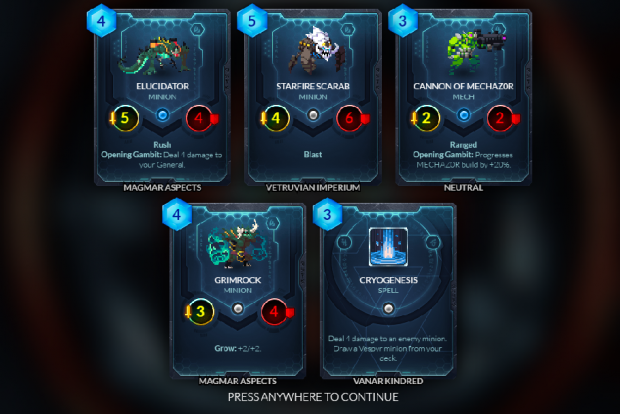
Worse case scenario, you’d get 4 commons and 1 rare (having at least a card with rare status or greater is guaranteed). Best case scenario you get multiple legendary-value cards. Even if you get a card you don’t need, you can disenchant them for spirit to craft the cards you want. Of course, the higher the rarity of the card, the more spirit you get if you disenchant them, but the amount received is less than the amount required to craft a card of that rarity.
Below are some other examples of cards:
Finally, there are fun daily challenges that tests a player’s understanding of game mechanics and card knowledge. It’s a great way to get acquainted with the game, improving your skills or just tinkering with a card you’ve never used before. Just as the name implies, daily challenges are unique and change every day.
Here’s an example of a daily challenge and overcoming one by Youtuber Game Dino:
Duelyst is that rare kind of game that tightropes accessibility and complexity with amazing finesse. It’s an incredibly competitive offering yet great if you just want quick half-an-hour sessions of brain stimulation. It’s free to play but unlike most games with that model, fully enjoying it isn’t obstructed by a massive paywall. It’s quirky, 80s pixel animations against the gorgeous vibrant landscape is a joy to the eyes and doesn’t require a supercomputer to run efficiently.
Try it. If you ever wanted to get into CCGs but found your wallet screaming at you, try Duelyst. Brain stimulation and tactical combat has never been this engrossing for the price of nothing.
Find out more about the game and the developers behind it by tuning into their Facebook, Twitter and Youtube pages. Of course you could simply visit their official website right here!











